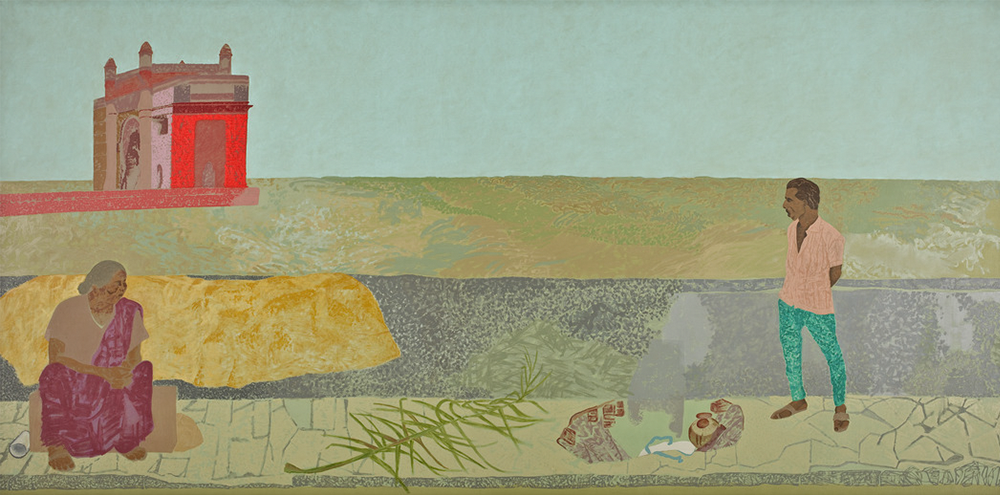Narrative Figuration
Bhupen Khakhar’s work fit into a broader movement in the 1970s towards narrative figuration, meaning figures placed in real and imagined contexts and spaces to tell a story. This movement was centered in Baroda and Bombay. Khakhar, Gulam Sheikh, and Vivan Sundaram (to the extent he was associated with Baroda) were three of the leading artists associated with this movement in Baroda, while turning to artists in Bombay offers us the opportunity to introduce new figures.
Let us look now at two leading artists who were integral to shaping narrative figuration, Gieve Patel and Sudhir Patwardhan. Like Khakhar was, Patel and Patwardhan are self taught artists. For most of their career they both also worked as practicing doctors in Bombay, as is evident in their treatment of the human body across their work.
Gieve Patel
Patel’s work has included poetic and empathetic takes on marginal and extreme figures. Throughout his career he has considered both “gross” and ordinary elements of urban life and the sometimes violent dimensions of mortality. Early in his career, his works centered on images of single figures, a key example being his painting Dead Politician, which presents an ironic depiction of a possibly corrupt deceased politician covered in live garlands. Later he began to incorporate complex narratives in his compositions, as in Gateway and Early Morning Local, both painted in 1981 and presenting different aspects of life in Bombay. The former uses the iconic Gateway of India to ground the work, which presents two figures in an otherwise unmarked setting, while the latter presents a typical if uncrowded local train berth in the city. While he has often returned to images of solitary figures throughout his career, his works also continued to integrate more layers and complexity. He painted one of his seminal narrative works, Off Lamington Road, a symbolic yet typical street scene in an area of Bombay not far from his medical clinic, after a visit to Italy, where he saw important Renaissance frescoes. He was particularly impacted by Pietro Lorenzetti’s representation of a crowd at the foot of the cross in a chapel at Assisi.
Sudhir Patwardhan
Patwardhan identifies with Leftist politics and for a long time was keenly involved in local politics. Of those working in and around Bombay in the late 1970s and early 1980s, Patwardhan was a rare example of a Maharashtrian artist to rise to national and then international acclaim. Patwardhan paints “peopled landscapes” principally drawn from life around Thane, where he has lived and worked since the start of his career. Concerned with the interplay of intimacy and distance, he does not paint ‘snapshots,’ but instead conflates multiple moments onto a canvas without a feeling of compression. This can be seen in Accident on May Day of 1981, which depicts a crowded train platform with passersby carrying an injured man on a stretcher. Through representations of life in the city and its suburbs, Patwardhan addresses class differentiation, social mobility or lack thereof, poverty, and urbanization. Building off of principles of realism, Patwardhan represents his subjects and surroundings in an accessible manner, so that his work is not only portraying the masses but is also legible across class and educational divides. He has also made great efforts throughout his career to create opportunities to expand the audience for his work beyond the traditional art going public.
Let’s look now in more depth at an example of his approach. With Street Play of 1981, Patwardhan offers an acute indication of the conflicts in his social, intellectual, and personal perspectives as participant or observer. Street Play uses a three-part composition that brings together three disjointed, differently-scaled segments of an urban panorama. The painting depicts a shadowed mill at left, and in the central plane a street located in central Bombay, with a passing bus at right. Patwardhan uses two sections of a seemingly matched car to unite the left and center panels, and replicates the main actor and white railing from the central frame in the right panel to link those two sections. The focus of the painting is the “street play” in center, which depicts middle-class leftist intellectuals performing a play about social injustice, intended to be seen by both the mill workers and upper-class citizens of the city who might pass by. Patwardhan equates his own artistic practice with the role of the street performers.
Let’s turn now to Patwardhan’s iconic Overbridge from 1985. In Overbridge, Patwardhan shows the central figures at eye level facing the viewer. Through this device, the narrative of the work functions differently than Patel’s Off Lamington Road or Street Play, connecting with Patwardhan’s politics and more directly with his social interests. The work depicts, from an overbridge, a narrowing view of Kurla, a culturally heterogeneous middle-class Bombay suburb that was once a hub of the city’s textile mill industry. The central figure, at the front of the visual plane, depicts a despairing worker, who stares out blankly. In positioning the figure to face the observer, Patwardhan forces the viewer and subject to confront each other directly.
To the right of the bridge is a textile mill, a gray building. A sign attached to a tower behind the mill, visible only in part, seems to read “swadeshi,” which likely refers to the Swadeshi Cotton Mills Corporation, and further — obliquely maybe — to the name of the nationalist, indigenist art movement that developed in Bengal beginning in 1905 studied in Lesson 2. The bridge compositionally divides the work so that most of Kurla is to its left, and only the gray textile mill and scattered, individual figures are at right. The darkened, cloudy sky over the right side of the work forecasts the impending decline of the textile industry in Bombay around this time.






